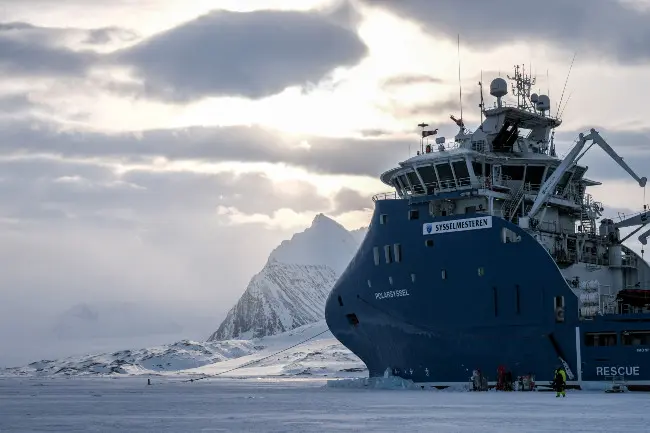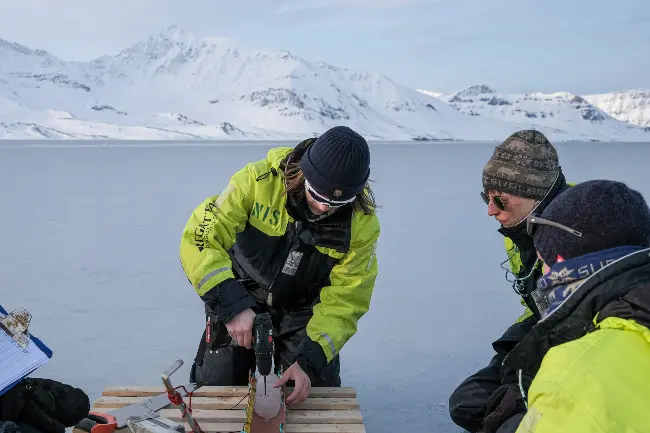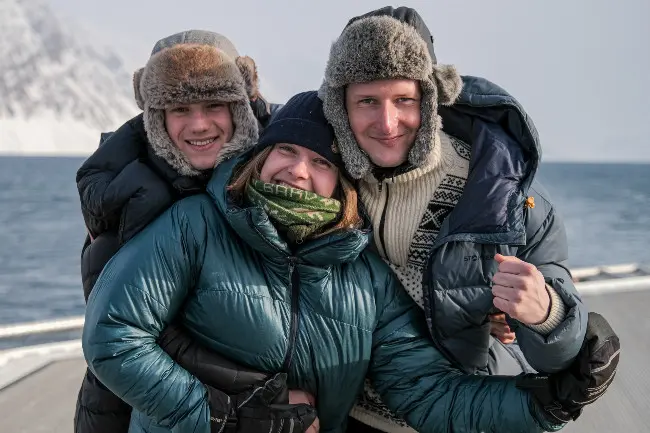Jump straight into it – a year at UNIS

AGF-student collecting water-samples. Photo: Maria Philippa Rossi/UNIS
Top image: During the scientific cruise the students took part in different data collecting. Here, Johanne has collected one of many CTD-samples (salinity, temperature and depth). Photo: Maria Philippa Rossi/UNIS
A dedicated high school teacher inspired Johanne Ordahl to pursue geophysics as her field of study. After a year at UNIS, she has secured a summer job at MET, and she’s already planning that her master thesis writing will take her back to Svalbard.
10 April, 2022
Text: Maria Philippa Rossi
We all remember that one great teacher, don’t we? The one where we did the homework, never skipped a class, and after every 45-minute session felt wiser, calmer and a with sense of control of the subject? Such a teacher inspired Johanne Ordahl to study geophysics.
— I had a high school teacher in geoscience who was very passionate about her teaching. We went on fieldwork to Longyearbyen and Iceland, which was super cool. She was so enthusiastic, she loved what she did and introduced me to this field of study. I just knew that this was my call.
The 22-year-old, originally from Eidsvoll, is about to finish her bachelor in Geophysics at the University of Oslo. She has spent the last year in Longyearbyen studying Polar Meteorology and Climate, Polar Ocean Climate, Snow and Ice Processes and Air–Ice–Sea Interaction.

Fieldwork to write home about
Johanne sits in a reclining chair on board the Governor’s ship Polarsyssel. The ship is moored into the sea ice in St. Jonsfjorden, northwest on Spitsbergen. The scientific cruise is a part of the field work for AGF-211, Air-Ice-Sea Interaction. For a week the students are out at sea and in the ice, doing measurements and collecting data for their final reports.
— I really like this way of working. We are doing something real, we are seeing the changes. This is not something the teacher have told us, we’re getting the data ourselves. We are doing the same things, using the same instruments as what they would on big research expeditions.
She highlights Ragnheid Skogseth, a professor in Physical Oceanography, and how the students’ fieldwork contributes to her longtime profile of the conditions in Isfjorden.
— We don’t play around, we are actually doing something. It makes us feel important too, Johanne says.

Ice, ice, baby
Johanne and a fellow student are in charge of ice coring, and every day they’ve been out making cores and taking measurements.
— I’m looking at ice cores, both new and old ice. I want to see how the salinity and temperature changes throughout the ice core. I want to find out if it has any connection with currents, or how far out in the fjord the cores are taken. An ice core can say a lot about the history during the winter.
The students are divided into small groups who look at different topics. They also learn their fellow students to operate their instruments and get help data sampling.
The fieldwork gets repetitive, but the conditions the students have had in St. Jonsfjorden over the past few days have been pristine. She looks up towards the clear, blue sky.
— I’m really interested in the different types of clouds, what they do, both in general, but also in relation to climate change, she says.
— In all climate models, the clouds are what causes most uncertainty.
Looking at the weather forecast, she won’t get many clouds during the week.

Practical learning curve
Johanne went to “folkehøgskole” on the west coast of Norway, and spent the majority of the year hiking the mountains, kayaking, or skiing.
— We used the nature every day. I think that was also why I want to go and study in such a remote place like Svalbard, instead of being in the middle of the city.
She had prepared for the brown, golden colours of Spitsbergen in the autumn, and says she loved to experience the changing seasons.
— Even though the polar night came closer, it was light because of the snow. I thought I would struggle with the cold, but it was actually quite nice.
She is very happy with how the semester is laid out, with a period of lectures at the start, then time for fieldwork and report writing in the end.
— I think it’s nice that we have time to enjoy the surroundings of Longyearbyen as well. A semester in Svalbard is much more than just school. We often go for a long hike on Saturday or Sunday, make a bonfire or go cross country skiing across the fjord. But you don’t have to feel bad if you want to spend the day indoor watching a movie; there are always people who are up for that as well.

Great, new friends
Moving from a flat in Oslo to living in the Elvesletta student housing with others, sharing a kitchen and common facilities has been an experience.
— I have really appreciated getting to know the international students, their culture, and their routines. Last semester the Germans had an evening where they made all this super typical German food – it was so nice!
Getting to know her fellow students has been a priority, and she has purposedly not had many visitors.
— I didn’t want to mix up old friends with new ones. I wanted it to be my year.
Moving to a new place to study always comes with its challenges, but Johanne offers some advice; be open, don’t worry about your English not being perfect, and be curious and patient.
— We are many different people, and we must adjust to each other. I’ve become more responsible, less afraid, and more grown-up during my year here.
She laughs, but underlines the importance of being challenged and pushed out of your comfort zone.
— I’ve become less afraid of trying new things up here. For instance, in the field, I’ve done a lot of programming. It’s not something I did back home. I also got a summer job at the MET office; I would probably never have applied if it hadn’t been for my experience from UNIS.
— I’ve learnt to jump straight into it.
Her last comment fits conveniently. It’s the last day on the ice, and tradition is that the students go for a swim in the water they’ve studied over the past few days.
Johanne ends up doing seven laps in the freezing water.
